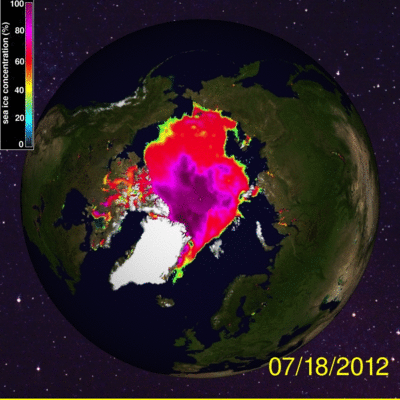~First ever sea and ice temperature profiles extracted by refraction observations.
~Already helped proving buoy top thermistors measuring wrong temperatures
~It is hoped to be a useful for Sea ice dedicated coupled models.
It has been known that GRIB model can't duplicate exact Arctic Ocean sunset geometry, or not calculate near surface inversions exactly by either failing to replicate an inversion temperature profile or missing to forecast them all together. Mass Buoys also exaggerate the solar warming of its top thermistors, I noticed this when a consistent isotherm was observed a few weeks after end of long night over NW passage sea ice horizon after every Local Apparent Noon. When sea ice horizon elevation is identical to the true astronomical horizon it means that top of sea ice and the air right above have identical temperatures. During Spring from Southern Cornwallis Island Nunavut Canada shores, a stable isotherm was seen lasting from a few minutes during first day it was observed to nearly half a day several weeks later, even when quite cold temperatures persisted. This contradicted buoy data suggesting an adiabatic profile with top sea ice air warmer than surface air at 2 meters.
There is substantial data to extract from horizon observations throughout the entire Arctic year. The following figure encapsulates the main temperatures profiles of sea water, ice and air over the entire year:
Temperature profiles determined by Horizon Elevations can be very useful to check Gridded GCM's. Here is the summary of all phases of sea ice throughout the Arctic year. Some temperature profiles are truncated in order to fit the sketch. It would be desirable to see a similar figure created by a coupled model.
From left to right there are about 9 recognizable horizon elevation changes which stem
from significant temperature changes on part of or the entire temperature profile comprising either two or three different mediums.
Late Summer 74N 95W:
High Arctic surface temperatures may vary between -5 to +5 C. At +5 C there can be a temperature inversion over a sea with sst's not usually exceeding +4 C.
Early Autumn;
Surface temperatures normally vary from -3 to -10 C, it is common to observe the true astronomical horizon when sea surface temperature is equal to surface air.
Middle Autumn;
Is the time when sea water subsists despite colder -5 to -15 C air temps. When the temperature is seasonal minimum cold, the horizon drops to is lowest point of the year.
Late fall;
Fast ice forms usually after October 1, especially during the last 10 years as opposed to early and mid September in the further away recent past. Something spectacular
occurs with the horizon when grey ice starts to be prominent, the horizon is seen very low with open water, and jumps to above Astronomical Horizon in less a day after sea ice completely covers all the way to the horizon, the ice accretes till "first melt".
Early Winter;
With the beginning of long night (early November), the sea ice horizon very slowly rises day by day until it vanishes in the night.
Mid Winter;
Is marked by temperatures between -25 and -40 C with only daily noon twilight for bright light. The horizon is much higher at sunrise from the long night compared to when sea ice first set completely. But there are some variances caused by advection of either cold or warmer air. New ice usually is about 1 meter thick. By mid February, the effects of solar radiation increases horizon elevations even more, especially in the evening, to highest levels until mid-April.
Late Winter;
A surprising view occurs when the astronomical horizon is the same as the ice horizon for the first time since mid October, it is "first melt", when the sun is high enough in the sky to eradicate the very persistent inversion giving horizon continuously above astronomical horizon. "First melt" likely happens at bottom of the ice column, but the horizon rises a few minutes after and the bottom refreezes. Over the last 4 years , "first melt " dates occurred on different dates, 2010 being the earliest. After FM, the sea bottom thaws and refreezes daily. With a gradual progression of longer and longer horizons at same astronomical level, only interrupted by snowfall, clouds or fog, the ice bottom remains more less the same. From this time the ice column warms slowly as well.
Early Spring;
Day by day the Astronomical horizon is achieved at longer and longer intervals.
Post Local Apparent Noon Isotherms subsist right above the ice. The ice rots at bottom.
But in the evening with lower sun in sky, the horizon rises, inversions occur diurnally, and exist from evening to early morning when sunny, they even happen during cloudy periods. The ice column warms more and more, contributing to ice bottom rot. But there is cold ice "middle" core which helps cool the adjoining air faster thus causing the horizon to rise. In time, the cold ice core becomes quite insignificant, the astronomical horizon period extends to nearly all day.
Late spring;
The onset of melt ponds should lower the horizon below astronomical horizon, but the ponds must cover most of the ice all the way to the horizon. If so, an adiabatic profile subsists from top of ice surface upwards. Both top and bottom ice starts to melt. Sea water temperatures increase slowly, necessary to melt sea ice depleted of salt, which has a point of fusion closer to 0 degrees C. A sea ice column may subsist even with temperatures nearest or just above -1.8 C, provided brine has been flushed away. WD May23, 2015


























